1989 MITSUBISHI GALANT set clock
[x] Cancel search: set clockPage 58 of 1273
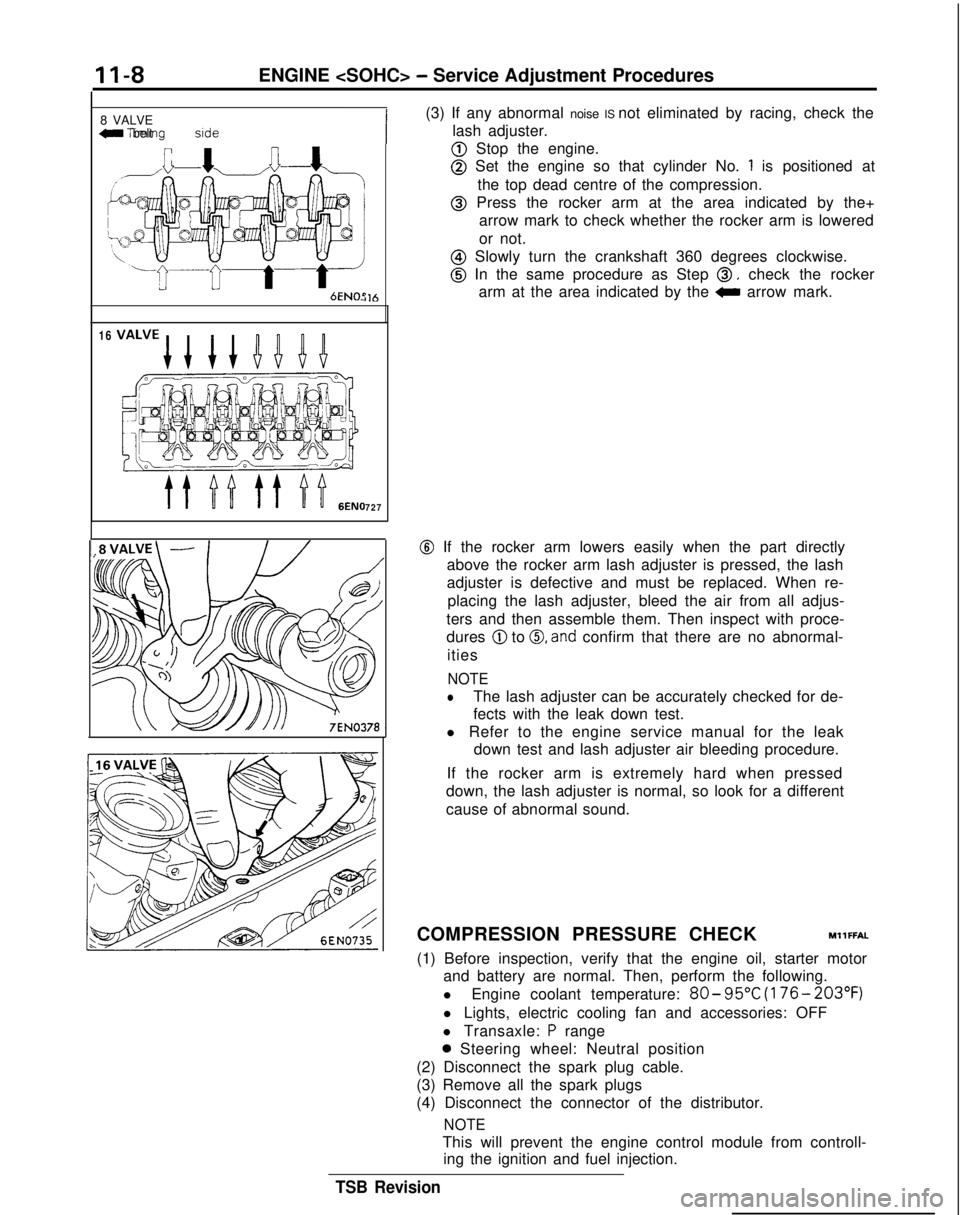
II-8ENGINE
8 VALVE
W Tlmlng belt side
il6
16
727
(3) If any abnormal noise IS not eliminated by racing, check the
lash adjuster.
@ Stop the engine.
@ Set the engine so that cylinder No. 1 is positioned at
the top dead centre of the compression.
@ Press the rocker arm at the area indicated by the+ arrow mark to check whether the rocker arm is lowered
or not.
@ Slowly turn the crankshaft 360 degrees clockwise.
@ In the same procedure as Step 0, check the rocker
arm at the area indicated by the
0 arrow mark.
@ If the rocker arm lowers easily when the part directly
above the rocker arm lash adjuster is pressed, the lash
adjuster is defective and must be replaced. When re-
placing the lash adjuster, bleed the air from all adjus-
ters and then assemble them. Then inspect with proce-
dures
@ to 0, and confirm that there are no abnormal-
ities
NOTE
lThe lash adjuster can be accurately checked for de-
fects with the leak down test.
l Refer to the engine service manual for the leak down test and lash adjuster air bleeding procedure.
If the rocker arm is extremely hard when pressed
down, the lash adjuster is normal, so look for a different
cause of abnormal sound.
COMPRESSION PRESSURE CHECK
MllFFAL
(1) Before inspection, verify that the engine oil, starter motor and battery are normal. Then, perform the following.
l Engine coolant temperature:
80- 95°C
(176- 203°F)
l Lights, electric cooling fan and accessories: OFF
l Transaxle:
P range
0 Steering wheel: Neutral position
(2) Disconnect the spark plug cable.
(3) Remove all the spark plugs
(4) Disconnect the connector of the distributor.
NOTE
This will prevent the engine control module from controll- ing the ignition and fuel injection.
TSB Revision
Page 61 of 1273

ENGINE
Access
cover
,-
(0 a0
<
0 0
0 0
0
101 II0221
Access cover
Screwdriver slot
3EN075
(9) Remove the air conditioning drive belt and the generator drive belt.
(10)Removle the access covers. There are easily removed by
inserting a screwdriver into the slots indicated by the raised
arrows in the timing belt cover and twisting. (1l)lnset-t
the special tool (MD998051-01)
from the pivot side
access hole and loosen the tension spacer (with a tensioner lock nut on it) 1 to 2 turn.
Next insert a 14 mm socket wrench from the slot side
access hole and loosen the tensioner lock bolt 1 to 2 turn.
(12)Turn the crankshaft clockwise by two teeth of the camshaft
sprocket.
(13)First ticjhten the timing belt tensioner installation bolt (on
the
lo&er side), and then tighten the tensioner spacer
(upper side).
Caution
Be sure to tighten the bolt (lower side) first. lf the
tensioner spacer of pivot side is tightened first, the
tensioner will rotate with it and belt tension may
becorn; loose.
(14)lnstall the access cover. The access cover may be easily
installeNd by passing the hooks between the guides and
sliding it in.
(15)lnstall the air conditioning drive belt and generator drive
belt and adjust the slack. (Refer to P.l
l-l 2.)
(16)lnstall the timing belt front upper cover.
(17)lnstall the engine mounting bracket.
(18)lnstall the spark plugs.
(19)lnstall the left side undercover panel.
TSB Revision
Page 101 of 1273
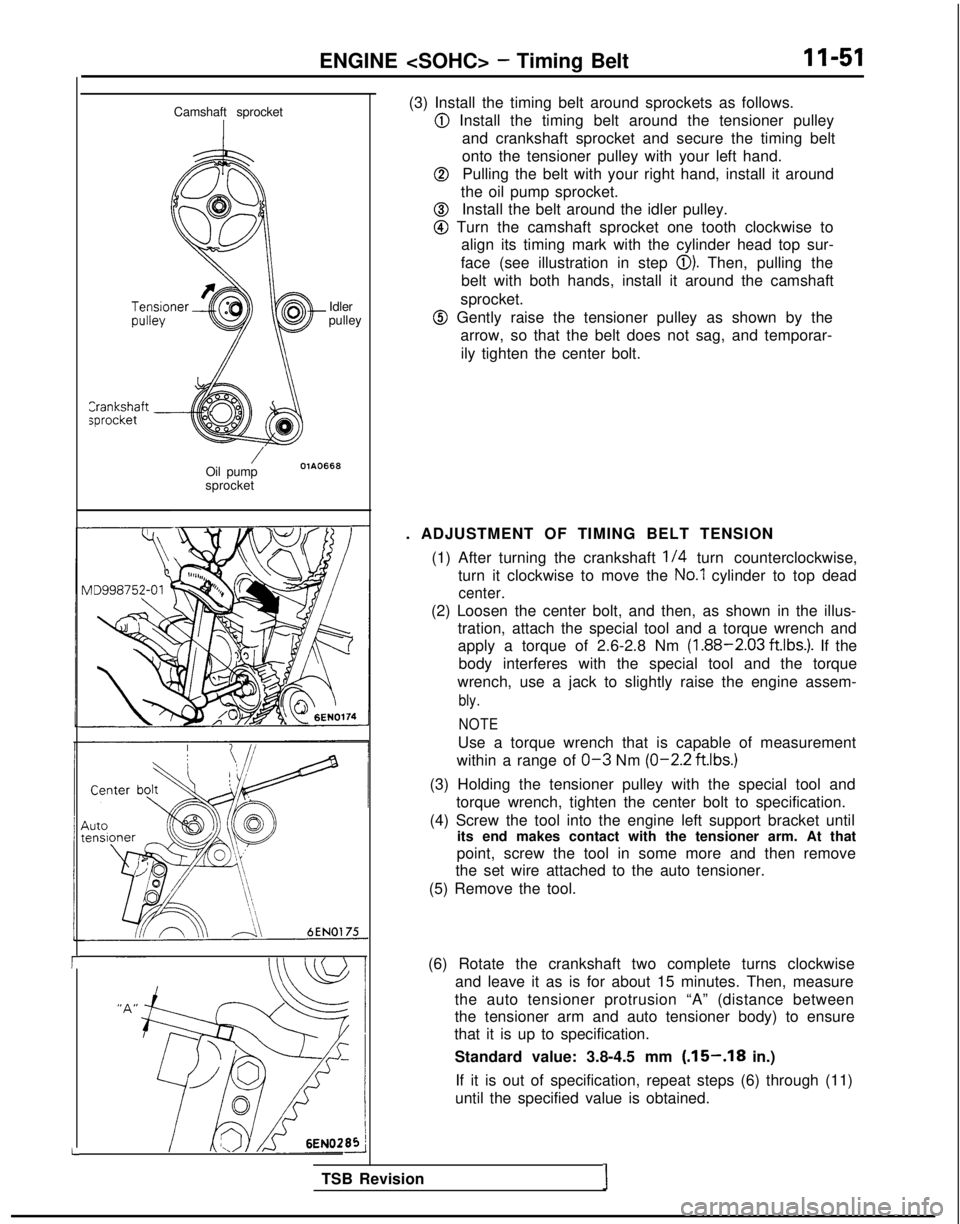
ENGINE
r
L Camshaft sprocket
Idler
pulley
/Oil pumpOlA0668
sprocket
6EN0175
(3) Install the timing belt around sprockets as follows.
@ Install the timing belt around the tensioner pulley
and crankshaft sprocket and secure the timing belt
onto the tensioner pulley with your left hand.
@Pulling the belt with your right hand, install it around
the oil pump sprocket.
@Install the belt around the idler pulley.
@ Turn the camshaft sprocket one tooth clockwise to align its timing mark with the cylinder head top sur-
face (see illustration in step
0). Then, pulling the
belt with both hands, install it around the camshaft
sprocket.
@ Gently raise the tensioner pulley as shown by the arrow, so that the belt does not sag, and temporar-
ily tighten the center bolt.
. ADJUSTMENT OF TIMING BELT TENSION (1) After turning the crankshaft
l/4 turn counterclockwise,
turn it clockwise to move the
No.1 cylinder to top dead
center.
(2) Loosen the center bolt, and then, as shown in the illus- tration, attach the special tool and a torque wrench and
apply a torque of 2.6-2.8 Nm
(1.88-2.03 ft.lbs.). If the
body interferes with the special tool and the torque
wrench, use a jack to slightly raise the engine assem-
bly.
NOTE
Use a torque wrench that is capable of measurement
within a range of
O-3 Nm (O-2.2
ftlbs.)
(3) Holding the tensioner pulley with the special tool and
torque wrench, tighten the center bolt to specification.
(4) Screw the tool into the engine left support bracket until its end makes contact with the tensioner arm. At that
point, screw the tool in some more and then remove
the set wire attached to the auto tensioner.
(5) Remove the tool.
(6) Rotate the crankshaft two complete turns clockwise and leave it as is for about 15 minutes. Then, measure
the auto tensioner protrusion “A” (distance between
the tensioner arm and auto tensioner body) to ensure
that it is up to specification.
Standard value: 3.8-4.5 mm
(.15-.18 in.)
If it is out of specification, repeat steps (6) through (11)
until the specified value is obtained.
TSB Revision
I
Page 108 of 1273
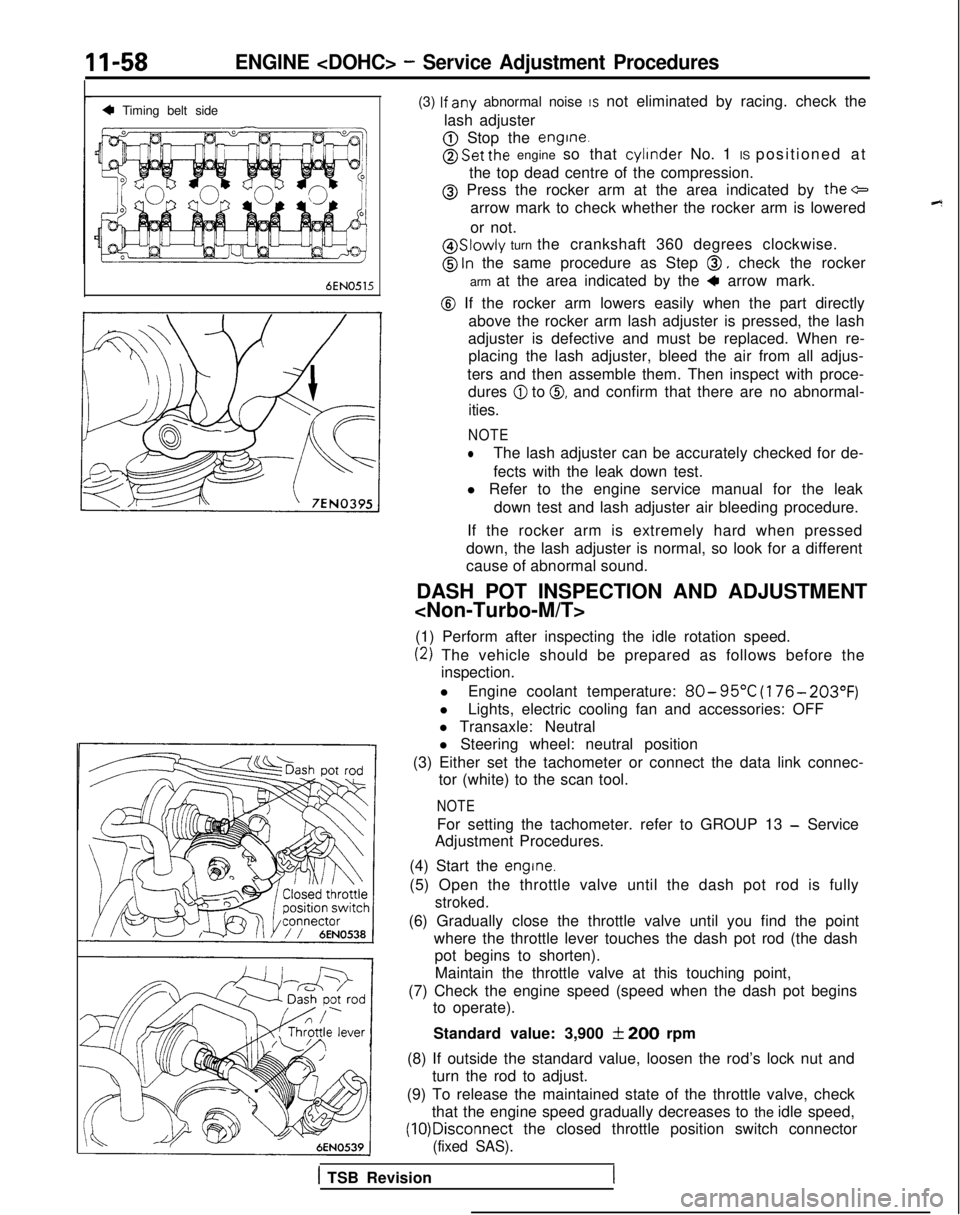
11-58ENGINE
4 Timing belt sideI
6EN0515
(3) lf
any abnormal noise IS not eliminated by racing. check the
lash adjuster
@ Stop the engine.
@ Set the engine so that cylinder
No. 1 IS positioned at
the top dead centre of the compression.
@ Press the rocker arm at the area indicated by the+
arrow mark to check whether the rocker arm is lowered
or not.
@ Slowly turn the crankshaft 360 degrees clockwise.
@ ln the same procedure as Step 0, check the rocker
arm at the area indicated by the
4 arrow mark.
@ If the rocker arm lowers easily when the part directly above the rocker arm lash adjuster is pressed, the lash
adjuster is defective and must be replaced. When re- placing the lash adjuster, bleed the air from all adjus-
ters and then assemble them. Then inspect with proce- dures
@I to 0, and confirm that there are no abnormal-
ities.
NOTE
lThe lash adjuster can be accurately checked for de-
fects with the leak down test.
l Refer to the engine service manual for the leak
down test and lash adjuster air bleeding procedure.
If the rocker arm is extremely hard when pressed
down, the lash adjuster is normal, so look for a different
cause of abnormal sound.
DASH POT INSPECTION AND ADJUSTMENT
(1) Perform after inspecting the idle rotation speed.
(2) The vehicle should be prepared as follows before the inspection.
l Engine coolant temperature:
80- 95°C
(176- 203°F)
lLights, electric cooling fan and accessories: OFF
l Transaxle: Neutral
l Steering wheel: neutral position
(3) Either set the tachometer or connect the data link connec- tor (white) to the scan tool.
NOTE
For setting the tachometer. refer to GROUP 13 - Service
Adjustment Procedures.
(4) Start the
engine.
(5) Open the throttle valve until the dash pot rod is fully
stroked.
(6) Gradually close the throttle valve until you find the point where the throttle lever touches the dash pot rod (the dashpot begins to shorten).
Maintain the throttle valve at this touching point,
(7) Check the engine speed (speed when the dash pot begins to operate).
Standard value: 3,900
f 200 rpm
(8) If outside the standard value, loosen the rod’s lock nut and turn the rod to adjust.
(9) To release the maintained state of the throttle valve, check that the engine speed gradually decreases to the idle speed, (10)Disconnect
the closed throttle position switch connector
(fixed SAS).
1 TSB Revision
Page 141 of 1273
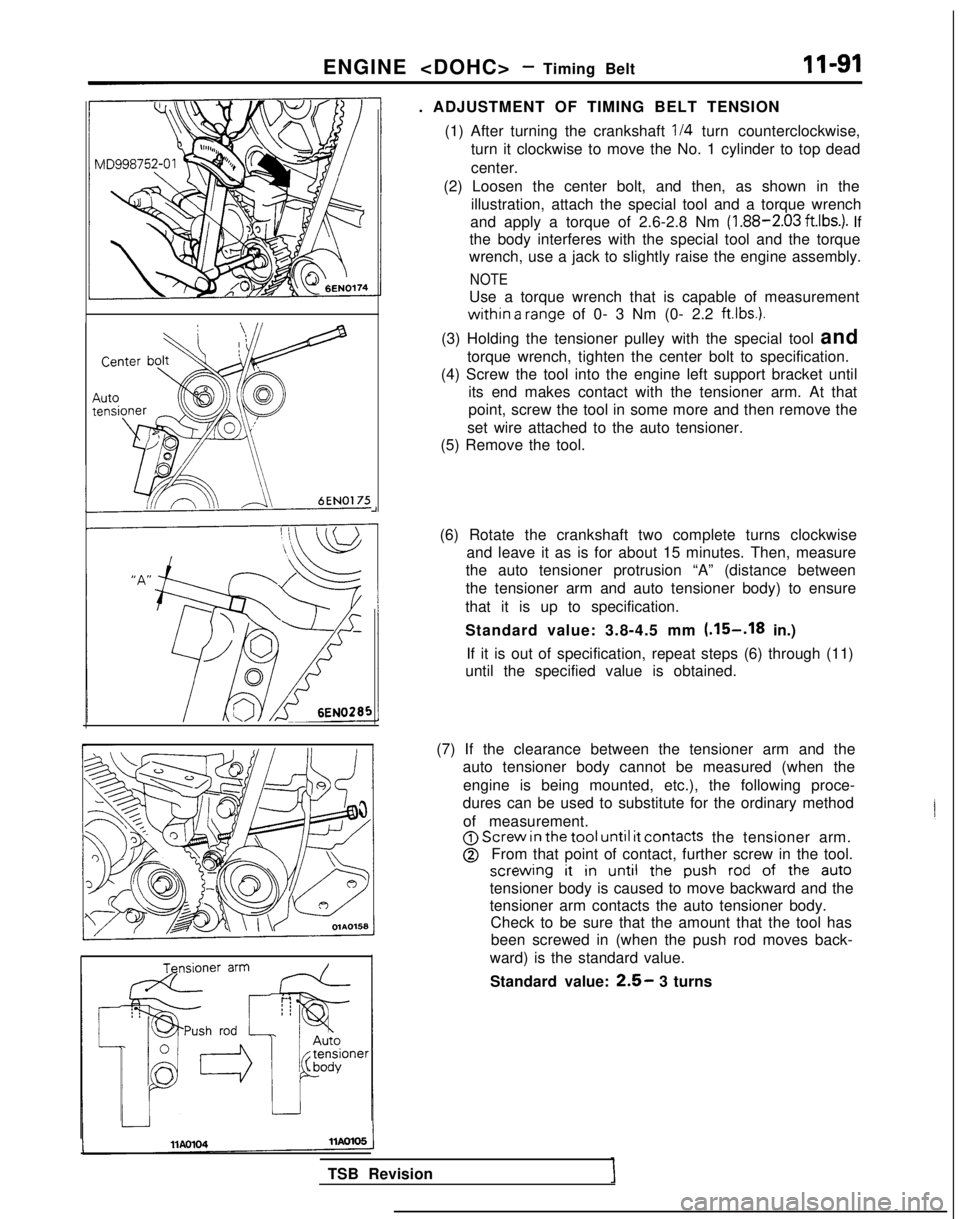
ENGINE
J
Tensioner armTensioner arm
TSB Revision
. ADJUSTMENT OF TIMING BELT TENSION
(1) After turning the crankshaft
l/4 turn counterclockwise,
turn it clockwise to move the No. 1 cylinder to top dead
center.
(2) Loosen the center bolt, and then, as shown in the illustration, attach the special tool and a torque wrench
and apply a torque of 2.6-2.8 Nm (1.88-2.03
ft.lbs.). If
the body interferes with the special tool and the torque
wrench, use a jack to slightly raise the engine assembly.
NOTE
Use a torque wrench that is capable of measurement
within a range of 0- 3 Nm (0- 2.2 ftlbs.).
(3) Holding the tensioner pulley with the special tool and torque wrench, tighten the center bolt to specification.
(4) Screw the tool into the engine left support bracket until its end makes contact with the tensioner arm. At that
point, screw the tool in some more and then remove the
set wire attached to the auto tensioner.
(5) Remove the tool.
(6) Rotate the crankshaft two complete turns clockwise and leave it as is for about 15 minutes. Then, measure
the auto tensioner protrusion “A” (distance between
the tensioner arm and auto tensioner body) to ensure
that it is up to specification.
Standard value: 3.8-4.5 mm
(.15-.I8 in.)
If it is out of specification, repeat steps (6) through (11)
until the specified value is obtained.
(7) If the clearance between the tensioner arm and the auto tensioner body cannot be measured (when the
engine is being mounted, etc.), the following proce-
dures can be used to substitute for the ordinary method
of measurement.
@j Screw in
the tool until it
contacts the tensioner arm.
@From that point of contact, further screw in the tool.
screwing it in
until the push
rod
of the auto
tensioner body is caused to move backward and the
tensioner arm contacts the auto tensioner body.
Check to be sure that the amount that the tool has
been screwed in (when the push rod moves back-
ward) is the standard value.
Standard value:
2.5- 3 turns
Page 279 of 1273
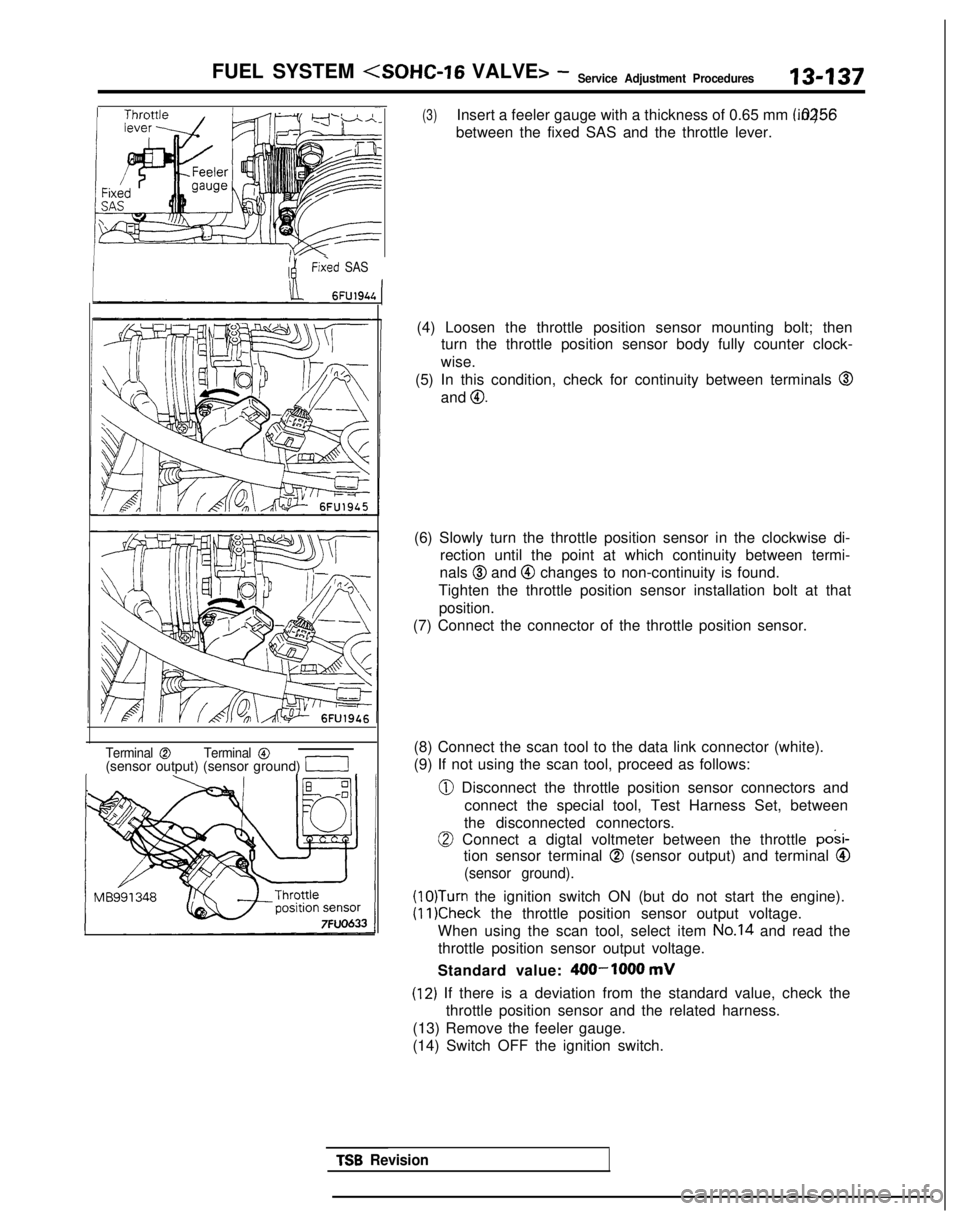
FUEL SYSTEM
I;gFixed SAS
Terminal @Terminal @(sensor output) (sensor ground) /
(3)Insert a feeler gauge with a thickness of 0.65 mm (.0256 in.)
between the fixed SAS and the throttle lever.
(4) Loosen the throttle position sensor mounting bolt; then turn the throttle position sensor body fully counter clock-
wise.
(5) In this condition, check for continuity between terminals
@
and 0.
(6) Slowly turn the throttle position sensor in the clockwise di- rection until the point at which continuity between termi-
nals
@I and @ changes to non-continuity is found.
Tighten the throttle position sensor installation bolt at that position.
(7) Connect the connector of the throttle position sensor.
(8) Connect the scan tool to the data link connector (white).
(9) If not using the scan tool, proceed as follows:
0 Disconnect the throttle position sensor connectors and connect the special tool, Test Harness Set, between
the disconnected connectors.
0 Connect a digtal voltmeter between the throttle posi-
tion sensor terminal
@ (sensor output) and terminal Q
(sensor ground).
(lO)Turn the ignition switch ON (but do not start the engine).
(11)Check the throttle position sensor output voltage.
When using the scan tool, select item
No.14 and read the
throttle position sensor output voltage.
Standard value:
400-1000 mV
(12) If there is a deviation from the standard value, check the throttle position sensor and the related harness.
(13) Remove the feeler gauge.
(14) Switch OFF the ignition switch.
TSB Revision